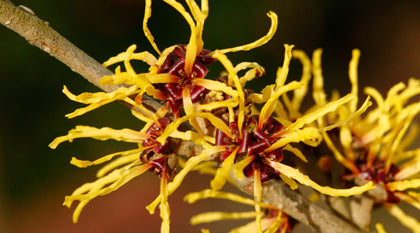 Long after summer concludes, and the floral landscapes have faded, witch hazel’s flowers blossom with a fiery like yellow hue, in the backdrop of gloomy autumn weather. Growing between 5 to 15 feet, this deciduous plant can be found in North America, throughout partially shaded, damp areas, lining streams and wooded land. Growing wide, each branch creates its own path of grayish bark and oval leaves. Once established, this beautiful shrub-like plant becomes maintenance free and resistant to most pests and diseases, bringing both beauty and ease to the owner.
Long after summer concludes, and the floral landscapes have faded, witch hazel’s flowers blossom with a fiery like yellow hue, in the backdrop of gloomy autumn weather. Growing between 5 to 15 feet, this deciduous plant can be found in North America, throughout partially shaded, damp areas, lining streams and wooded land. Growing wide, each branch creates its own path of grayish bark and oval leaves. Once established, this beautiful shrub-like plant becomes maintenance free and resistant to most pests and diseases, bringing both beauty and ease to the owner.
Witch hazel has shiny black seeds that are contained in a hard, round seed pod that split open upon reaching maturity. If the seeds are disturbed by inclement weather or animals, they will hurl from the capsule with a loud, popping sound, landing as far as 20-30 feet away. This surprising characteristic is believed to be the reason for the common nickname “Snapping Hazelnut”. While there is some history connecting this plan to witches, it is believed the name “witch hazel” actually comes from the old English word “wych”, meaning pliable branches.
When Native Americans saw this plant blooming at a time when the autumn leaves were lit up in tones of bright reds and yellows, they soon recognized that there was a uniqueness, unlike any other plant. This created a curiosity among the tribes, leading to the discovery of its medicinal use and Witch Hazel was then used by tribes to treat many ailments. Its astringent properties were used for skin sores, inflammations, boils, and hemorrhoids - a use that is still very common in modern times.
As settlers arrived in America, they learned about the medicinal properties of witch hazel from the Native Americans, allowing the beneficial uses to continue for centuries to come. The true medicinal use of witch hazel became widely known the 1840’s, when Theron T. Pond of Utica, NY studied the usage of this plant by the Oneida Indians. He found that they were using it for burns, boils, and wounds. It was then that he created “Golden Treasure”, made by steeping the shrub in an everyday teakettle, creating an extract that could be used internally and externally. The liquid, which he obtained, was colored but clear as water and had a unique fragrance, unlike any other plant. Golden Treasure, otherwise known as Pond’s Extract, was the first mass-marketed American manufactured toiletries. The use of witch hazel was one of the only medicinal plants approved by the FDA in the early 1900s as a non-prescription drug, and its distilled extracts can still be found on most pharmacy shelves. Its extracts are used in many cosmetics and skin-care products, including aftershaves.
Witch hazel’s leaf and bark contain tannins that have astringent properties and can help stop internal and external bleeding. An herbal salve or poultice can be used to treat varicose veins, swelling, bruises, and hemorrhoids. A tea of witch hazel can be used for burns, insect bites, and inflamed swellings. As a soothing herb, witch hazel has been found to relieve tired muscles and perineal soreness, reduce pain and take the itching and bleeding out of hemorrhoids.
At Motherlove, you will find witch hazel in our Sitz Bath Spray and Rhoid Balm. We recommend that moms have these products on hand for use after delivery, to relieve any discomfort that may arise. Spraying a pad with the Sitz Bath Spray is a great way for on the go relief. The Rhoid Balm is compact, in a 1oz jar, and can be easily packed in a diaper bag or handbag, for convenient use.



